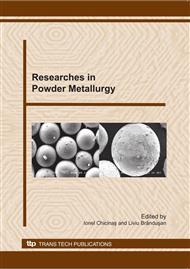p.187
p.191
p.195
p.203
p.207
p.215
p.219
p.223
p.229
Material Data for Modelling Density Distributions in Green Parts
Abstract:
Die compaction of powders is a process which involves filling a die with powder, compaction using rigid punches to form a dense compact and ejection from the die. The process can be treated as a large deformation plasticity problem. The challenge is to develop and implement appropriate constitutive models that capture the evolution of the powder from a loose state into a dense compact. In this paper we describe data analysis procedures and calibrate classic incremental plasticity models, such as Cam-Clay, Drucker-Prager cap models. The complexity of the models is increased from models with a hardening law to more complex constitutive models using density as state variable. The compaction behaviour of a range of powder materials is characterized experimentally. Numerical simulation of the compaction of simple parts and complex parts is demonstrated. The merits of various models are evaluated in terms of the balance between complexity and practicality. The discussion is illustrated with case studies exploring the applicability of the models specific to various powder pressing scenarios.
Info:
Periodical:
Pages:
207-214
Citation:
Online since:
January 2011
Authors:
Price:
Сopyright:
© 2011 Trans Tech Publications Ltd. All Rights Reserved
Share:
Citation:


